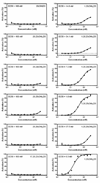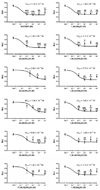Endogenously produced nonclassical vitamin D hydroxy-metabolites act as "biased" agonists on VDR and inverse agonists on RORα and RORγ
- PMID: 27693422
- PMCID: PMC5373926
- DOI: 10.1016/j.jsbmb.2016.09.024
Endogenously produced nonclassical vitamin D hydroxy-metabolites act as "biased" agonists on VDR and inverse agonists on RORα and RORγ
Abstract
The classical pathway of vitamin D activation follows the sequence D3→25(OH)D3→1,25(OH)2D3 with the final product acting on the receptor for vitamin D (VDR). An alternative pathway can be started by the action of CYP11A1 on the side chain of D3, primarily producing 20(OH)D3, 22(OH)D3, 20,23(OH)2D3, 20,22(OH)2D3 and 17,20,23(OH)3D3. Some of these metabolites are hydroxylated by CYP27B1 at C1α, by CYP24A1 at C24 and C25, and by CYP27A1 at C25 and C26. The products of these pathways are biologically active. In the epidermis and/or serum or adrenals we detected 20(OH)D3, 22(OH)D3, 20,22(OH)2D3, 20,23(OH)2D3, 17,20,23(OH)3D3, 1,20(OH)2D3, 1,20,23(OH)3D3, 1,20,22(OH)3D3, 20,24(OH)2D3, 1,20,24(OH)3D3, 20,25(OH)2D3, 1,20,25(OH)3D3, 20,26(OH)2D3 and 1,20,26(OH)3D3. 20(OH)D3 and 20,23(OH)2D3 are non-calcemic, while the addition of an OH at C1α confers some calcemic activity. Molecular modeling and functional assays show that the major products of the pathway can act as "biased" agonists for the VDR with high docking scores to the ligand binding domain (LBD), but lower than that of 1,25(OH)2D3. Importantly, cell based functional receptor studies and molecular modeling have identified the novel secosteroids as inverse agonists of both RORα and RORγ receptors. Specifically, they have high docking scores using crystal structures of RORα and RORγ LBDs. Furthermore, 20(OH)D3 and 20,23(OH)2D3 have been tested in a cell model that expresses a Tet-on RORα or RORγ vector and a RORE-LUC reporter (ROR-responsive element), and in a mammalian 2-hybrid model that test interactions between an LBD-interacting LXXLL-peptide and the LBD of RORα/γ. These assays demonstrated that the novel secosteroids have ROR-antagonist activities that were further confirmed by the inhibition of IL17 promoter activity in cells overexpressing RORα/γ. In conclusion, endogenously produced novel D3 hydroxy-derivatives can act both as "biased" agonists of the VDR and/or inverse agonists of RORα/γ. We suggest that the identification of large number of endogenously produced alternative hydroxy-metabolites of D3 that are biologically active, and of possible alternative receptors, may offer an explanation for the pleiotropic and diverse activities of vitamin D, previously assigned solely to 1,25(OH)2D3 and VDR.
Keywords: 1,25D3-MARRS; CYP11A1; Hydroxyvitamin D; RORα; RORγ; VDR.
Published by Elsevier Ltd.
Conflict of interest statement
The authors declare no conflict of interest
Figures








References
-
- Holick MF, MacLaughlin JA, Doppelt SH. Regulation of cutaneous previtamin D3 photosynthesis in man: skin pigment is not an essential regulator. Science. 1981;211:590–593. - PubMed
-
- Holick MF. The cutaneous photosynthesis of previtamin D3: a unique photoendocrine system. J Invest Dermatol. 1981;77:51–58. - PubMed
-
- Holick MF. Biological Effects of Sunlight, Ultraviolet Radiation, Visible Light, Infrared Radiation and Vitamin D for Health. Anticancer Res. 2016;36:1345–1356. - PubMed
-
- Holick MF. Vitamin D: A millenium perspective. J Cell Biochem. 2003;88:296–307. - PubMed
-
- Bikle DD. Vitamin D: an ancient hormone. Experimental Dermatology. 2011;20:7–13. - PubMed
Publication types
MeSH terms
Substances
Grants and funding
LinkOut - more resources
Full Text Sources
Other Literature Sources

